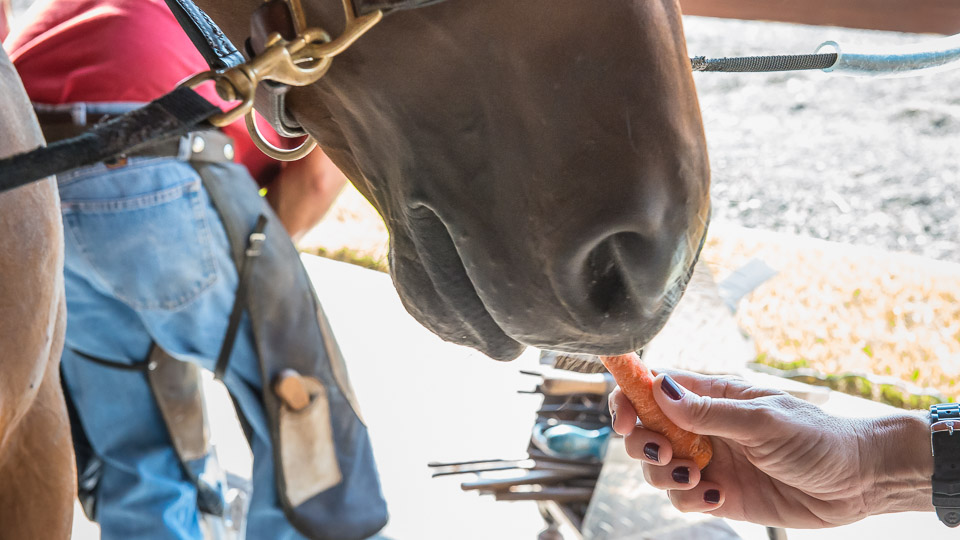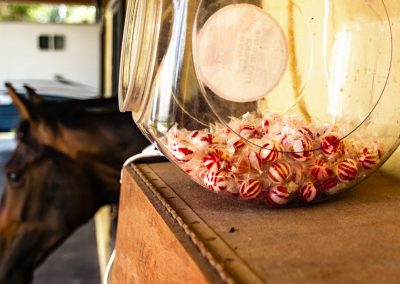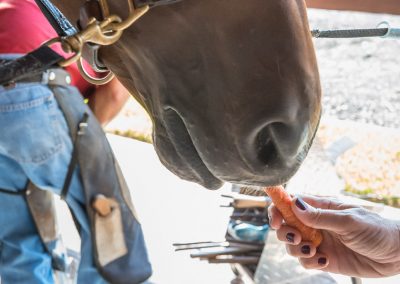
Horsemanship – Do Not Reward Bad Behavior
I love teaching this principle to new horse owners because as soon as I describe it, a complete and instant understanding is made. Training by reward is very effective even if the thing you are training the horse is NOT what you wanted to train.
An example of this is a horse who paws at the stall door because it is feeding time. Feeding him is rewarding him for this obnoxious, noisy and damaging behavior. Whenever you acknowledge a behavior you are rewarding it. When a horse paws in the cross ties and you yell at him, it is giving attention to the horse and rewarding it by giving it this attention.
It takes courage and extreme patience to ignore bad behavior but by ignoring it you are effectively training the horse to NOT do the behavior. This is the principle of cheerleading versus coaching. Cheerleading involves positive encouragement for any behavior that is wanted. A horse that stops pawing in crossties should be praised with positive words of how proud you are of this wanted behavior.
**CONTINUED IN ARTICLE TAB**
Related material – Sometimes I have a lot of material here that I have written, podcasted, video blogs and other things. They will be listed in this tab.
Use the browser back button or menu to return to the index of topics.
⬇︎ CLICK ANY IMAGE BELOW TO REVEAL MORE INFORMATION ⬇︎
I love teaching this principle to new horse owners because as soon as I describe it, a complete and instant understanding is made. Training by reward is very effective even if the thing you are training the horse is NOT what you wanted to train.
An example of this is a horse who paws at the stall door because it is feeding time. Feeding him is rewarding him for this obnoxious, noisy and damaging behavior. Whenever you acknowledge a behavior you are rewarding it. When a horse paws in the cross ties and you yell at him, it is giving attention to the horse and rewarding it by giving it this attention.
It takes courage and extreme patience to ignore bad behavior but by ignoring it you are effectively training the horse to NOT do the behavior. This is the principle of cheerleading versus coaching. Cheerleading involves positive encouragement for any behavior that is wanted. A horse that stops pawing in crossties should be praised with positive words of how proud you are of this wanted behavior.
We all know that it doesn’t work this way, right? So the horse starts pawing again. You now have 2 choices. Erupt with frustration and scream at him thus rewarding him with the attention you are giving him. Or you can dig deep into your reservoir of patience and turn your attention elsewhere thus not rewarding him with attention. Both work well but unfortunately, the ignoring bad behavior takes patience and mental strength on your part.
Remember that when you start barking orders to stop something you are nagging and no one likes that. Also remember that this works with people too. Try it sometime when someone annoys you. Just pretend that you are training yourself to be better with your horses. Also try to think of what I have heard from people raising children – choose your battles wisely.
There are some things you need to stop when they occur such as a horse nipping or biting. In this case a swift and accurately focused discipline needs to be applied in no uncertain terms that the horse (who is bigger, stronger and faster than you) can understand that doing that behavior again is not in his best interest. It is NOT beating. But rules need to be enforced or they are not rules and doing harm to me is a rule that must never be broken. Here is a story from my 2nd year with horses.
I was feeding a horse in a row of 11 stalls and this mare was about the 7th horse I had gotten to. She was a little excited at this point. To feed her I needed to open the stall door, enter the stall and then move the length of the stall to the corner where the feed tub was located. I would dump the grain in and then back trace my steps out the door. The routine was simple and was accepted by all horses except for this day with this horse. Her excitement was high pitched.
As I entered the stall and moved towards the corner, she spun and kicked out with both hind feet aiming directly for me. It was just pure excitement for her though I now know it was probably just gut inflasmmation and nutritionally caused hyperexciteability. It was 1975 and plastic buckets did not exist then. We used galvanized steel pails. I immediately threw the grain filled pail at the horse = actually over the horse – where it hit the wall, bounced off the wall with such a metal racket and spilled all of the grain throughout the stall into the bedding. I screamed at her, “There! Are you happy now? Was it worth it? If you’re hungry you can find your food buried deep in yout straw bedding. Have a great day!” As she stood wide eyed in the far corner I left her and her bucket in the stall.
My rule that I should never be hurt by a horse from an attack had been broken and a punishment opposite in effect to ignoring was given. It was swift, done without anger and memorable. From that day forward for as long as I knew that mare, feeding time was a period of mutual respect and we became great friends for the rest of our time together. I also praised her every time she behaved reenforcing her good behavior.
For the majority of the bad behaviors horses do, first decide if it is worth paying attention to. If it is, be effective without anger. If it is not then ignoring it works better than bullying and nagging. Always reward good behavior even if it is your 100th time doing so – it never is bad to reward good behavior. Never reward bad behavior because it is a reflection of weakness on your part and a trigger to repeat the bad behavior for the attention the horse needs from it.
This video is all about never rewarding bad behavior. You won’t hear a word from either of us except a “Good girl” about the 12 minute mark. Also note the energy of the humans and the horse.
- Additional tables
- Links to other in house articles
- Links to outside articles
- Reference material used in developing this topic.
There are no related articles here if you don’t see linked items.




Responses